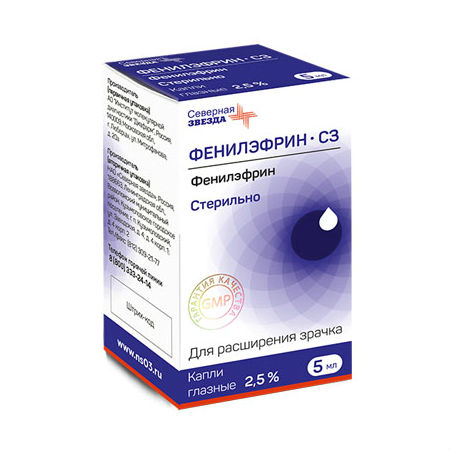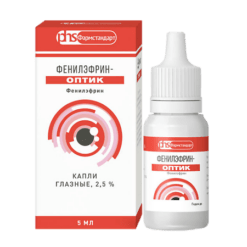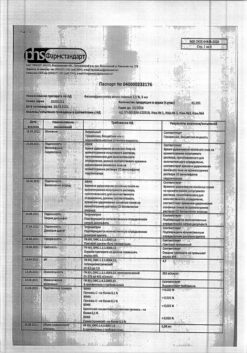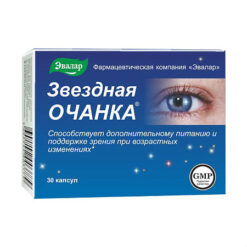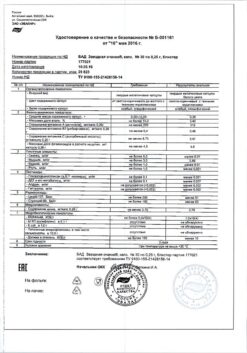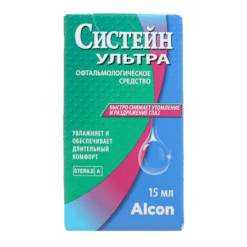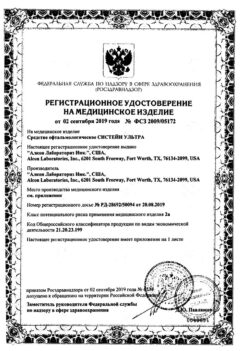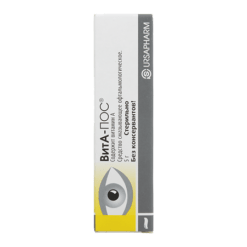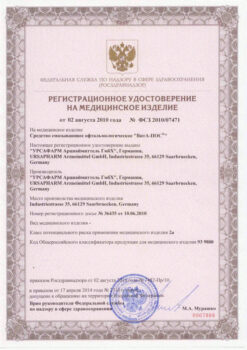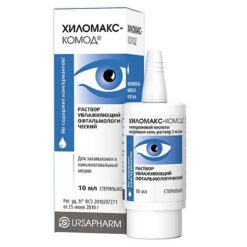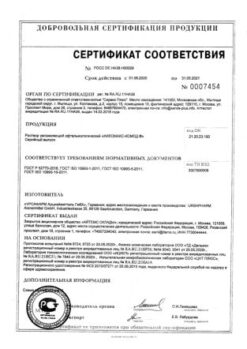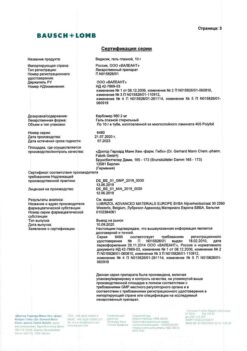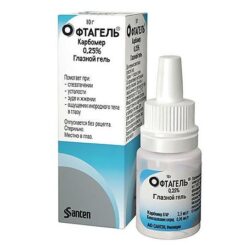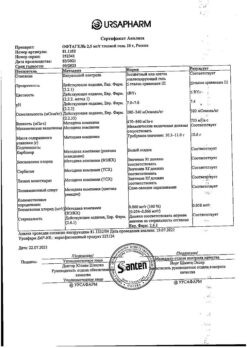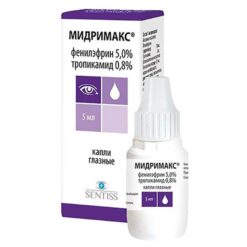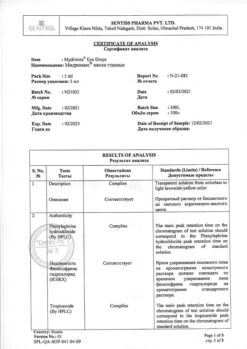No products in the cart.
Phenylephrine-SZ, eye drops 2.5% 5 ml
€9.28 €8.12
Description
Phenylephrine is an alpha-adrenomimetic with pronounced non-selective alpha-adrenomimetic action. When used in therapeutic doses it does not have significant stimulating effects on the central nervous system.
When used topically in ophthalmology, it causes dilation of the pupil, improves the outflow of intraocular fluid and narrows the conjunctival vessels.
It has little effect on beta-adrenoreceptors, including those in the heart (no positive chrono- and inotropic action). The drug has a vasoconstrictor effect similar to that of norepinephrine (noradrenaline). The vasopressor effect of phenylephrine is weaker than that of norepinephrine, but it is longer lasting. Causes vasoconstriction 30-90 seconds after instillation, duration 2-6 hours.
Phenylephrine instillation is followed by contraction of the dilator of the pupil, resulting in mydriasis, and contraction of the smooth muscles of the conjunctival arterioles. Mydriasis occurs within 10-60 minutes after a single instillation, persists for 2 hours, and is not accompanied by cycloplegia.
Phenylephrine easily penetrates into the eye tissues and reaches its maximum concentration in plasma 10-20 minutes after instillation into the eye. Prior instillation of local anesthetics may increase systemic absorption of phenylephrine and prolong mydriasis.
Phenylephrine is excreted by the kidneys unchanged (< 20%) or as inactive metabolites.
Indications
Indications
Iridocyclitis (to prevent the occurrence of posterior synechiae and reduce exudation from the iris).
For diagnostic pupil dilation during ophthalmoscopy and other diagnostic procedures necessary to monitor the condition of the posterior segment of the eye.
Conducting a provocative test in patients with a narrow anterior chamber angle profile and suspected angle-closure glaucoma.
Differential diagnosis of superficial and deep injection of the eyeball.
Red eye syndrome (to reduce hyperemia and irritation of the mucous membrane of the eye).
Spasm of accommodation.
Pharmacological effect
Pharmacological effect
Pharmacodynamics
Phenylephrine is an alpha-adrenomimetic, has a pronounced non-selective
alpha-adrenomimetic effect. When used in therapeutic doses, it does not have a significant stimulating effect on the central nervous system.
When applied topically in ophthalmology, it causes dilation of the pupil, improves the outflow of intraocular fluid and constricts the vessels of the conjunctiva.
Weak effect on beta-adrenergic receptors, including the heart (does not have a positive chrono- and inotropic effect). The drug has a vasoconstrictor effect similar to that of norepinephrine (norepinephrine). The vasopressor effect of phenylephrine is weaker than that of norepinephrine, but is longer lasting. Causes vasoconstriction 30-90 seconds after instillation, duration 2-6 hours.
After instillation of phenylephrine, the pupillary dilator contracts, which leads to mydriasis, and the smooth muscles of the conjunctival arterioles contract. Mydriasis occurs within 10-60 minutes after a single instillation, persists for 2 hours and is not accompanied by cycloplegia.
Pharmacokinetics
Phenylephrine easily penetrates the eye tissue, the maximum plasma concentration is reached 10-20 minutes after instillation into the eye. Pre-instillation of local anesthetics may increase systemic absorption of phenylephrine and prolong mydriasis.
Phenylephrine is excreted by the kidneys unchanged (<20%) or in the form of inactive metabolites.
Special instructions
Special instructions
Exceeding the recommended dose of a 2.5% solution in patients with injuries, diseases of the eye or its appendages, in the postoperative period or with reduced tear production (anesthesia) may lead to increased absorption of phenylephrine and the development of systemic side effects.
The preservative benzalkonium chloride, which is part of the drug, can cause ulcerative toxic keratopathy with long-term use, especially in patients with concomitant diseases of the cornea and dry eye syndrome. Caution should be exercised when using the drug in this group of patients, and also ensure monitoring of the condition of the cornea if the drug is used frequently by such patients. Benzalkonium chloride may discolor soft contact lenses and cause eye irritation. Before instilling the drug, you must remove contact lenses and reinsert them no earlier than 15 minutes after instillation.
Impact on the ability to drive vehicles and machinery
After using the drug, due to changes in accommodation and pupil width, visual acuity may decrease, so until it is restored, it is not recommended to drive vehicles or engage in potentially hazardous activities that require increased concentration and speed of psychomotor reactions.
Active ingredient
Active ingredient
Phenylephrine
Composition
Composition
1 ml of the drug contains:
active ingredient:
phenylephrine hydrochloride – 25 mg;
excipients:
sodium edetate dihydrate – 1.0 mg,
citric acid – 1.0 mg,
sodium citrate dihydrate – 5.0 mg,
benzalkonium chloride – 0.1 mg,
sodium metabisulfite – 3.0 mg,
sodium hydroxide solution 1 M – to adjust the pH,
purified water – up to 1.0 ml.
Pregnancy
Pregnancy
The effect of phenylephrine in pregnant women has not been sufficiently studied, so the use of the drug during pregnancy is possible if the potential benefit to the mother outweighs the possible risk to the fetus.
In animals in late pregnancy, phenylephrine caused fetal growth retardation and stimulated early onset of labor.
It is not known whether the drug is excreted in breast milk. When prescribing the drug, it is recommended to stop breastfeeding during treatment.
Contraindications
Contraindications
Hypersensitivity to the components of the drug.
Narrow-angle or closed-angle glaucoma.
Old age.
Severe cardiovascular or cerebrovascular diseases.
Arterial hypertension in combination with coronary heart disease, aortic aneurysm, atrioventricular block I-III degree, arrhythmia.
Tachycardia.
Impaired tear production.
Prematurity; children under 6 years of age (with spasm of accommodation).
Hyperthyroidism.
Hepatic porphyria.
Congenital deficiency of glucose-6-phosphate dehydrogenase.
Rhinitis.
With caution
Diabetes mellitus (risk of increased blood pressure associated with impaired autonomic regulation).
Concomitant use with monoamine oxidase inhibitors (including within 21 days after stopping their use).
Sickle cell anemia, wearing contact lenses, after surgery (decreased healing due to conjunctival hypoxia).
Side Effects
Side Effects
From the side of the organ of vision
Conjunctivitis, periorbital edema.
In some cases, patients note a burning sensation at the beginning of use, blurred vision, irritation, a feeling of discomfort in the eye, lacrimation, and increased intraocular pressure.
Phenylephrine may cause reactive miosis the day after use. Repeated instillations of the drug over a short period of time may lead to less severe mydriasis than previously observed. This effect is more common in older patients.
Due to a significant contraction of the muscle that dilates the pupil, 30-45 minutes after instillation under the influence of phenylephrine, pigment particles from the pigment layer of the iris may be detected in the moisture of the anterior chamber of the eye. Suspension in the chamber fluid must be differentiated from manifestations of anterior uveitis or from the ingress of blood cells into the fluid of the anterior chamber.
Systemic reactions
From the skin and its appendages: contact dermatitis.
From the cardiovascular system: palpitations, tachycardia, arrhythmia, increased blood pressure, ventricular arrhythmia, reflex bradycardia, coronary artery occlusion, pulmonary embolism.
Interaction
Interaction
The mydriatic effect of phenylephrine is enhanced when used in combination with topical atropine. Due to increased vasopressor action, tachycardia may develop.
The use of phenylephrine with monoamine oxidase inhibitors, as well as within 21 days after stopping their use, should be used with caution, since in this case there is the possibility of an uncontrolled rise in blood pressure.
The vasopressor effect of alpha-agonists can also be potentiated when used simultaneously with tricyclic antidepressants, propranolol, reserpine, guanethidine, methyldopa and m-anticholinergics.
The mydriatic effect of phenylephrine is enhanced when used in combination with topical atropine. Due to increased vasopressor action, tachycardia may develop.
The use of phenylephrine with monoamine oxidase inhibitors, as well as within 21 days after stopping their use, should be used with caution, since in this case there is the possibility of an uncontrolled rise in blood pressure.
The vasopressor effect of alpha-agonists can also be potentiated when used simultaneously with tricyclic antidepressants, propranolol, reserpine, guanethidine, methyldopa and m-anticholinergics.
Overdose
Overdose
Symptoms: restlessness, nervousness, dizziness, sweating, vomiting, palpitations, weak or shallow breathing.
Treatment: if systemic effects of phenylephrine occur, side effects can be stopped by administering alpha-blockers, for example, 5-10 mg of phentolamine intravenously. If necessary, you can repeat the injection.
Storage conditions
Storage conditions
In a place protected from light, at a temperature not exceeding 25 oC.
Do not freeze.
Keep out of the reach of children.
Shelf life
Shelf life
2 years. Use within 28 days after opening the bottle. Do not use after the expiration date stated on the package.
Manufacturer
Manufacturer
Diapharm, Russia
Additional information
| Shelf life | 2 years. Use within 28 days after opening the bottle. Do not use after the expiration date stated on the package. |
|---|---|
| Conditions of storage | In a place protected from light, at a temperature not exceeding 25 oC. Do not freeze. Keep out of reach of children. |
| Manufacturer | North Star NAO, Russia |
| Medication form | eye drops |
| Brand | North Star NAO |
Other forms…
Related products
Buy Phenylephrine-SZ, eye drops 2.5% 5 ml with delivery to USA, UK, Europe and over 120 other countries.

